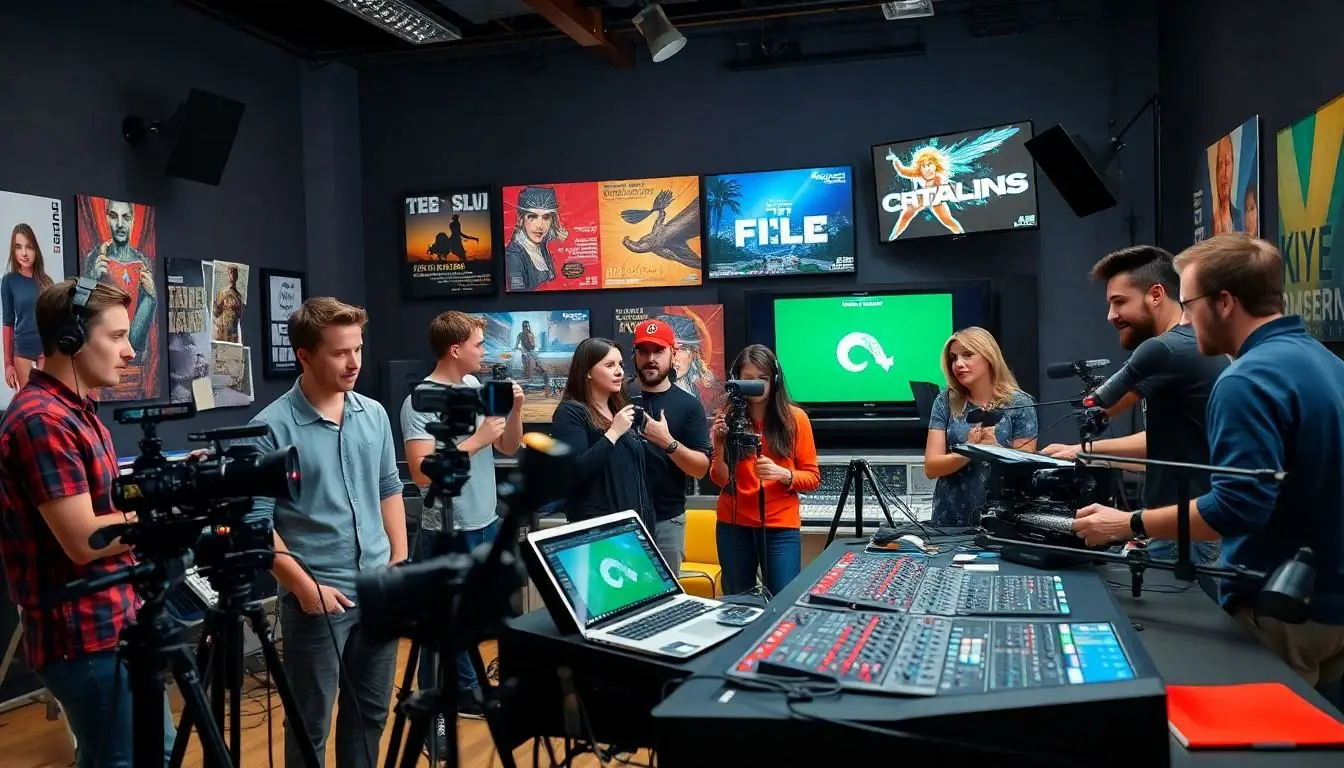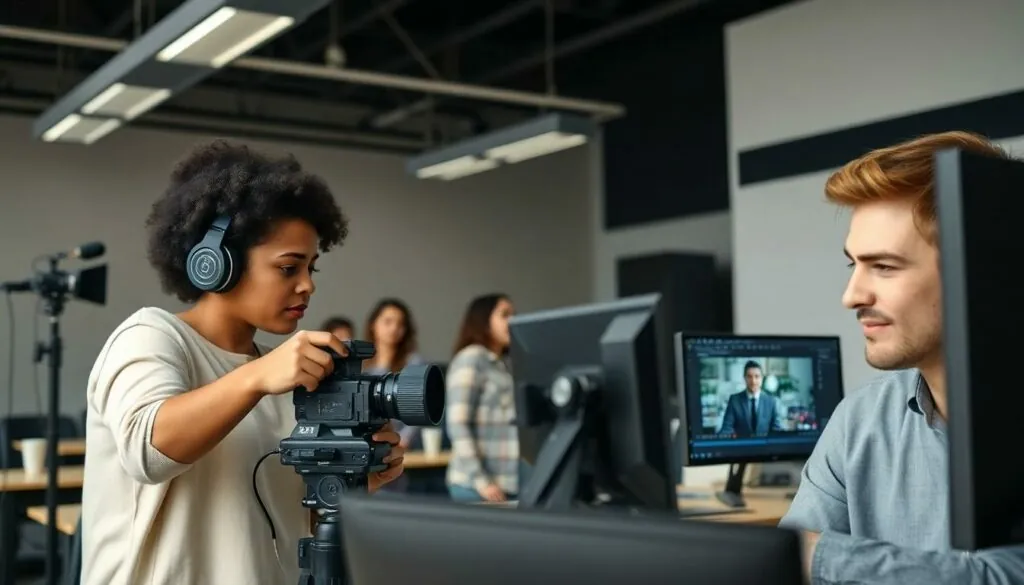Table of Contents
ToggleIn a world where every cat video goes viral and podcasts are the new rock stars, arts audio/video technology and communications education is more crucial than ever. It’s not just about pressing record; it’s about mastering the magic behind the scenes. Whether someone dreams of becoming the next Spielberg or wants to produce the ultimate TikTok sensation, understanding the educational landscape is key to unlocking those creative doors.
Overview of Arts Audio/Video Technology
Arts audio/video technology encompasses a wide range of skills and knowledge essential for various creative fields. This area includes video production, sound design, and multimedia communication, making it vital for students pursuing careers in entertainment and media. Building a solid foundation in these subjects leads to more opportunities in the industry.
Educational programs focus on technical skills, such as camera operation, lighting design, and sound recording. Students learn software applications commonly used in editing audio and video. Hands-on experience plays a crucial role, as students engage in projects that mimic real-world challenges faced by professionals.
Courses cover fundamental principles of storytelling, visual composition, and audio engineering. Students develop critical thinking skills that enhance their creative output. Workshops and internships often form part of the curriculum, allowing students to apply theory in practical settings.
Certifications in specific software and technology tools enhance employability. Understanding emerging technologies, including virtual reality and live streaming, positions graduates favorably in the job market. Knowledge of industry standards ensures that students are well-prepared for diverse roles within the field.
Networking opportunities at events, workshops, and trade shows aid in building professional connections. These relationships can lead to job opportunities or collaborations post-graduation. By participating in community projects, students also gain practical experience and contribute to local initiatives.
Overall, arts audio/video education equips individuals with technical and creative skills necessary for success in a rapidly evolving industry. Emphasis on both theory and practice prepares students for the diverse opportunities available within audio and video technology.
Key Skills Required for Success

Success in the arts audio/video technology and communications field relies on a mix of technical and creative skills.
Technical Skills
Proficiency in camera operation plays a vital role in capturing quality video content. Knowledge of lighting design enhances the overall visual appeal of projects. Understanding sound recording techniques ensures clear audio quality in productions. Familiarity with editing software is essential for post-production, allowing for seamless integration of audio and video elements. Mastery of emerging technologies such as virtual reality and live streaming can set individuals apart in the competitive job market. Certifications in specific software tools boost employability and demonstrate expertise to potential employers.
Creative Skills
Storytelling ability is fundamental for engaging audiences through multimedia content. Skill in visual composition shapes the aesthetic and narrative flow of projects. Critical thinking fosters innovative solutions to artistic challenges, enhancing overall creative output. Collaborative skills allow individuals to work effectively within teams, which is essential for large projects. Community project involvement enriches practical experience while building a professional network. Students must cultivate these creative skills alongside technical ones, promoting a well-rounded education for a successful career.
Educational Pathways
In arts audio/video technology and communications, varied educational pathways exist, catering to diverse career aspirations. Students can pursue degrees and certifications that equip them with essential skills for success in this dynamic field.
Degree Options
A bachelor’s degree in fields like film, media arts, or communications provides a comprehensive foundation. Programs often include courses in video production, sound engineering, and multimedia storytelling. Master’s degrees allow for deeper specialization, focusing on advanced technical and creative skills. Associate degrees serve as a quicker option, offering practical skills for entry-level positions. Many institutions also emphasize internships as part of their curriculum, fostering real-world experience while networking in the industry.
Certification Programs
Certification programs offer focused training on specific software and technology tools. Programs often cover industry-standard applications like Adobe Creative Suite and Pro Tools. Shorter than degree programs, certifications enhance employability by showcasing proficiency in technical skills. Many online platforms provide flexible options, allowing learners to study at their own pace. Emerging technologies are commonly included in curricula, helping students stay relevant in a rapidly changing market. Networking opportunities within these programs can lead directly to job placements.
Industry Standards and Accreditation
Accreditation plays a crucial role in ensuring quality and credibility in arts audio/video technology and communications education. Institutions recognized by accrediting bodies demonstrate adherence to high educational standards, which enhances the value of their programs.
Programs accredited by the National Association of Schools of Art and Design (NASAD) and the Accrediting Council on Education in Journalism and Mass Communications (ACEJMC) provide a level of assurance regarding their curriculum and faculty qualifications. These organizations set benchmarks that institutions must meet to maintain accreditation, addressing both academic rigor and practical relevance.
Students benefit from attending accredited programs as employers often prefer candidates from recognized institutions. Graduates of accredited programs tend to possess a solid foundation in technical and creative skills, which are essential for the industry. Comprehensive assessments and regular updates to curricula ensure institutions remain responsive to industry advancements.
Besides traditional accreditations, industry certifications in specific technologies and software can further validate a student’s expertise. Many programs encourage students to pursue certification in tools such as Adobe Creative Suite or Avid Media Composer, enhancing their employability and marketability.
Networking opportunities at accredited institutions provide students access to industry professionals and potential job prospects. Engaging with prominent figures during workshops and seminars can lead to internships or job placements, benefiting students’ careers long after graduation.
Maintaining high standards is vital as technology evolves. Continuous improvement through feedback from alumni and industry partners helps institutions align their educational offerings with current industry practices. Accreditation processes and industry certifications together create a robust framework for preparing students for success in the arts audio/video technology and communications fields.
Career Opportunities
Career opportunities in arts audio/video technology and communications continue to expand as digital content creation thrives. Graduates in this field can explore numerous paths that tap into their technical and creative skills.
Job Roles in Arts Audio/Video
Various job roles exist within the arts audio/video sector. Positions include video producer, where overseeing projects from conception to completion takes precedence. Audio engineer roles focus on sound recording and editing, ensuring high-quality audio output. Moreover, multimedia designer opportunities combine visual and audio elements for engaging presentations. Social media manager positions involve curating and creating content to enhance brand presence. Directors, editors, and animation specialists also play crucial roles in shaping narratives within film and video projects.
Growth Prospects
Growth prospects in arts audio/video technology show promising trends. The U.S. Bureau of Labor Statistics projects a 12% increase in job opportunities for audio and video technicians by 2030, indicating strong demand. Increased consumption of digital media and the rise of streaming platforms support this expansion. Emerging technologies, such as virtual reality and interactive media, further create new roles within the industry. Graduates who gain experience and adapt to industry shifts will find favorable chances for advancement. Continuous learning remains vital, as skills in software, design, and emerging tools will keep professionals competitive in a dynamic market.
Arts audio/video technology and communications education is vital for anyone looking to thrive in the digital content landscape. By combining technical skills with creative thinking, students are better prepared to meet the demands of an evolving industry.
Accredited programs ensure graduates possess the necessary expertise to stand out in a competitive job market. With a focus on hands-on experience and emerging technologies, these educational pathways not only enhance employability but also foster innovation.
As the industry continues to grow, embracing continuous learning and networking will be key for aspiring professionals. Those who adapt and expand their skill sets will find abundant opportunities waiting for them in the vibrant world of audio and video technology.

